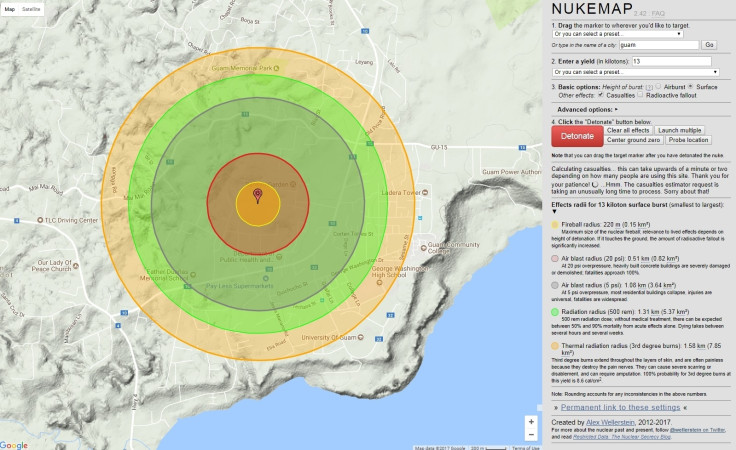What happens if North Korea drops a nuke on Guam? This website has the answer
Nukemap estimates death toll and damage to buildings when a bomb is dropped anywhere in the world.
Nukemap is an interactive website which can be configured to show what would happen if the US and North Korea dropped nuclear bombs on Guam and Pyongyang.
Created by Alex Wellerstein, a computer programmer and historian of nuclear weapons, Nukemap estimates the size of a nuclear bomb's fireball, air blast and thermal radiation radius, as well as how many people would be killed and injured in a chosen area.
The site has been deluged by traffic in recent days, after fears escalated over North Korea launching a missile strike against the US territory of Guam, an island in the western Pacific. The threat comes as the US believes North Korea has created a miniaturised nuclear warhead to be fitted to an intercontinental ballistic missile.
"I wake up in Kyoto and Nukemap is going crazy and everyone is asking about nuclear chain of command! What the heck," Wellerstein tweeted on 8 August.

According to Nukemap, if the largest nuclear weapon developed by North Korea, a 12 to 23.7 kiloton bomb tested in 2016, hit the heart of Guam it would create a fireball with a radius of between 210 and 290 metres.
Radiation with a 50-90% mortality rate would spread between three and six square kilometres, causing death between "several hours and several weeks". A 5psi air blast, where "most residential buildings collapse" would cover between three and 5.5 square kilometres, while thermal radiation causing third-degree burns would spread up to 12.6 square kilometres.
Nukemap estimates that the blast would cause 3,000 deaths and 12,700 injuries among the 163,000 residents of Guam, which is home to a US airbase.
On the other hand, if the US were to attack the North Korean capital of Pyongyang with the largest nuclear weapon in its arsenal, the 1,200 kiloton B-83, an estimated one million people would be killed and 843,000 would be injured.

The fireball would cover 5.7 square kilometres, an air blast causing most residential buildings to crumble would cover 74 square kilometres, and thermal radiation causing third-degree burns would extend to 11.6km from the blast site, covering 420 square kilometres.
But even this is a relatively small weapon compared to the USSR's 50 megaton Tsar Bomba, the largest hydrogen bomb ever tested. Dropped in 1961, it had a diameter of 2.1m and weighed 27,000kg.
Nukemap estimates, if dropped on Pyongyang, this would produce a fireball covering 67 square kilometres, an air blast spanning 1,350 square kilometres and thermal radiation would cover 11,300 square kilometres. Over 2.9m people would be killed and a further 1.3m would be injured.
© Copyright IBTimes 2024. All rights reserved.






